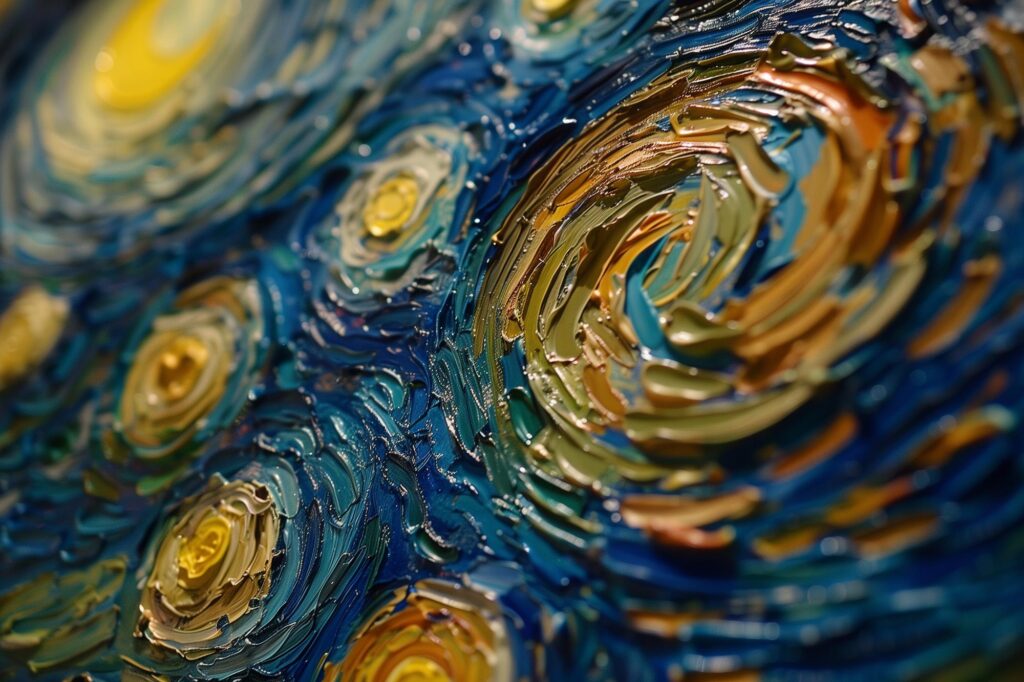
Vincent van Gogh’s “The Starry Night” is one of the most iconic paintings in art history, capturing a swirling, dream-like night sky that has fascinated viewers for over a century. Painted in 1889 during van Gogh’s stay at the Saint-Paul-de-Mausole asylum, the masterpiece radiates emotional intensity through its vibrant colors and dynamic patterns. However, “The Starry Night” is not only a masterpiece of artistic expression—it also holds within it a profound scientific phenomenon. The turbulent swirls and rhythmic flows in the sky have drawn the attention of scientists, mathematicians, and art historians alike, revealing intriguing parallels to fluid dynamics and the mathematical concept of turbulence.
In this exploration, we’ll uncover the science behind van Gogh’s famous swirls and delve into how “The Starry Night” unintentionally bridges the gap between art and physics. By examining both the technical elements of van Gogh’s painting process and the scientific theories that align with the artwork, we can appreciate “The Starry Night” as more than just a visual experience—it becomes a doorway into the mathematical beauty of nature.
The Mystery of Van Gogh’s Swirls
Upon first glance, “The Starry Night” is a celebration of nature’s beauty, with its stars, moon, and swirling clouds casting a sense of both wonder and chaos. Yet, there is something more profound happening within these swirling patterns. The painting is filled with forms that seem to pulse and move in a way that resembles natural, turbulent flows found in water, air, and even galaxies. Van Gogh’s ability to represent these chaotic, flowing forms with such precision and emotion has led many to wonder how he achieved this dynamic effect.
Turbulence is one of the most complex phenomena in physics, defined as the chaotic, unpredictable motion of fluids such as air or water. It is notoriously difficult to model mathematically due to its instability and non-linearity. Despite this complexity, van Gogh, perhaps unknowingly, managed to capture the essence of turbulence in “The Starry Night”. The clouds and stars appear to swirl and ripple in a way that mimics the behavior of turbulent flows, as though he intuitively understood the underlying patterns of this natural phenomenon.
What makes van Gogh’s depiction of turbulence particularly fascinating is that scientists have found actual mathematical correlations between his brushstrokes and the patterns of turbulence. Specifically, researchers have discovered that the swirling patterns in “The Starry Night” mirror a mathematical model known as the “Kolmogorov scaling law”, which is used to describe turbulent energy cascades. This connection between van Gogh’s artistic vision and a mathematical understanding of nature offers a unique perspective on the intersection of art and science.
Kolmogorov Scaling and Turbulence in “The Starry Night”
To understand how van Gogh’s painting aligns with the Kolmogorov scaling law, it’s important to briefly explore the concept of turbulence. In physics, turbulence refers to the irregular, chaotic movement of fluid that occurs when energy is introduced into a system, such as wind rushing through the atmosphere or water flowing over rocks in a river. The energy cascades down from large eddies (vortices) into smaller and smaller ones, creating a complex, fractal-like structure. This process is what gives turbulence its characteristic swirls, eddies, and ripples.
In 1941, Russian mathematician Andrey Kolmogorov developed a theory to describe the behavior of turbulence in fluids, particularly the way energy is transferred through different scales of motion. Kolmogorov’s scaling law allows physicists to quantify how turbulence behaves across different sizes of eddies, creating a mathematical framework for understanding this chaotic phenomenon.
Researchers studying “The Starry Night” have found that the luminance patterns—essentially the brightness and intensity of the colors in the swirling sky—closely resemble the turbulent patterns described by Kolmogorov’s law. By analyzing the flow of light and dark areas in the painting, scientists found that van Gogh’s brushstrokes closely align with the mathematical description of turbulence, particularly in the larger swirling structures around the stars and moon.
This discovery suggests that van Gogh may have intuitively understood the visual patterns of turbulence, even if he didn’t have a formal understanding of the physics behind it. His ability to capture the chaotic yet harmonious flow of nature in “The Starry Night” is a testament to his deep connection with the natural world, as well as his extraordinary artistic vision.
The Psychological Connection: Turbulence and Mental Health
While the scientific analysis of turbulence in “The Starry Night” provides a fascinating link between art and physics, there is another layer of complexity to consider: van Gogh’s mental state at the time he painted the masterpiece. The artist was known to struggle with mental illness, and “The Starry Night” was painted during his stay at the Saint-Paul-de-Mausole asylum, where he was recovering from a severe episode.
Many art historians and psychologists have speculated that the turbulent swirls in “The Starry Night” reflect van Gogh’s inner turmoil and emotional distress. The chaotic, swirling skies may symbolize his mental state, with the swirling patterns representing the uncontrollable forces of anxiety, depression, and mania that he experienced throughout his life. The way in which these swirls ebb and flow across the canvas, however, also suggests a sense of order amidst the chaos, perhaps hinting at van Gogh’s search for peace or control in the face of mental turbulence.
In this sense, “The Starry Night” can be viewed as a deeply personal reflection of van Gogh’s emotional and psychological landscape. The fact that these swirling patterns also align with scientific models of turbulence adds another layer of meaning to the painting, suggesting that van Gogh’s intuitive grasp of chaos may have been informed by his own experiences with mental disorder.
Van Gogh’s Unique Brushstrokes: The Science of Perception
Another scientific aspect worth exploring is van Gogh’s unique brushstroke technique and its effect on visual perception. His energetic, impasto style—where thick layers of paint are applied to the canvas—creates a texture that enhances the three-dimensional quality of the painting. The thickness of the paint adds depth to the swirling clouds and vibrant stars, making them appear almost as though they are moving off the canvas.
The impasto technique not only gives “The Starry Night” its signature tactile quality but also plays a crucial role in how viewers perceive the painting. The way van Gogh applied his brushstrokes—particularly in the sky—creates an optical illusion of motion, further emphasizing the swirling, turbulent nature of the scene. The texture and pattern of the brushstrokes trick the eye into seeing movement, drawing viewers into the rhythmic flow of the painting.
Researchers in the field of visual perception have noted that van Gogh’s use of contrasting colors—particularly the interplay between the blues of the sky and the yellows of the stars—also enhances the sense of depth and movement. By placing warm colors against cool ones, van Gogh creates a visual tension that heightens the dynamic quality of the painting. This use of color contrast is not only visually striking but also plays a role in how the brain interprets motion and depth in a two-dimensional image.
A Masterpiece of Art and Science
“The Starry Night” is more than just a beautiful painting—it is a testament to the intricate connections between art, science, and the natural world. Van Gogh’s ability to capture the chaotic beauty of turbulence, whether consciously or not, speaks to the universality of nature’s patterns, which can be found in everything from swirling galaxies to flowing rivers. The painting’s alignment with the mathematical models of turbulence demonstrates that art and science are not as separate as they may seem; both seek to understand and represent the world around us, often arriving at similar conclusions through different means.
For van Gogh, “The Starry Night” was a deeply personal work, reflecting both his inner emotional struggles and his profound connection to the natural world. Through his brushstrokes, van Gogh captured the invisible forces of nature—forces that science is still striving to understand. In doing so, he created a masterpiece that continues to captivate and inspire, inviting viewers to explore the swirling patterns of the universe through the lens of both art and science.
No comments yet.








